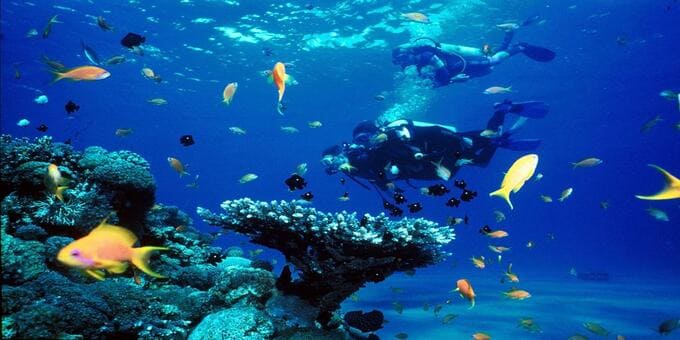About Diving in Hurghada:-
In the summer months, diving in Hurghada is particularly pleasant with a warm 28°C water temperature, but even in winter, it doesn’t drop below 20°C. So you have the best chances of encountering dolphins, turtles, and even (harmless) sharks all year round. The best time to visit Hurghada is April and May or October and November. These months are great for diving! It is easy to explain that these months are good for diving because the temperature in Hurghada is under 30°C and the temperature of the water is about 24°C. There are more wrecks reachable from Hurghada and shorter dive trips – leaving you time to notch up a few dives a day – or chill out back at your hotel. But Sharm El Sheikh does still have a couple of dive must-haves up its sleeves. Water quality – and coral health are a little better on Sharm’s shores. Local daily diving offers some perfect conditions for those new to diving. Hurghada is a great place for wreck enthusiasts; popular sites like the Thistlegorm and Giannis D are within reach of day trips too. Dive boats here are comfortable and purpose-built for divers. Abundant in natural resources and beauty, Hurghada’s name comes from a native plant to the area, and today is visited by many for its colorful coral reefs, luxurious resorts, beautiful dessert escapes, and refreshing Red Sea activities. Egypt’s tourist hotspots, including Hurghada and Sharm El-Sheikh, boast some of the country’s most renowned beach destinations and attract tourists as well as divers with its offshore coral reefs. However, these spots also seem to attract aggressive sharks, like the two unprovoked fatal attacks in Egypt in 2022.Depth: 10-30m at the main reef, terracing down to 60m+ Location: Around 80 mins from central Hurghada. Conditions: Often exposed to weather and strong currents. Some experience is required for the deep parts. Although they are on the coral reefs around Hurghada, we do not meet very often, in the Red Sea there are species that are considered dangerous (longfin shark, tiger shark or mako). Such types of sharks are most often found near reefs, where the wall falls to great depths and there are usually stronger currents. If you’re a fan of mountains, beaches, or both, then you will certainly get your fix if you visit Makadi Bay. Makadi Bay is 30 km from the south of Hurghada Airport. It has the Red Sea on one side, and the other has desert sand dunes and the Red Sea mountains. With a coastline stretching for over 40km, Hurghada is a holiday haven where sun-kissed sands meet the crystal-clear waters of the Red Sea – and it’s only five and a half hours away. Get up close to dolphins on a snorkel trip from Hurghada. Enjoy a boat tour to areas in the open sea where you can swim or snorkel with dolphins among colorful coral reefs. Swim with sea turtles and fish in Abu Dabab Bay on this full-day tour from Hurghada. One of Egypt’s top snorkeling and SCUBA sites, the clear, nationally protected bay is rich with colorful coral gardens and marine life. Hurghada has a sub-tropical desert climate with very hot dry summers and warm winters offering year-round sunshine. For the highest temperatures travel between April and October but a lot of holidaymakers visit during the winter months to experience a perfect blend of warmth and guaranteed sun. The tiger shark (Galeocerdo cuvier) from the Carcharhinidae family, which is also found in the Red Sea in Egypt, is one of the most dangerous sharks. We may see this species of shark while diving around Hurghada but very rarely. It accounts for 19% of human victims of shark attacks, but these events are extremely rare. Hurghada found on the western side of Egypt’s Red Sea Riviera is a beach town resort stretching some 40km along Egypt’s Red Sea coast. It is the second biggest town on the Red Sea, renowned for scuba diving, thanks to its beautiful coral reefs. For diving Hurghada, temperatures peak at 27-28°C during July to September. After these months the temperatures slide slightly down from 27-25°C in October and November. They continue their downward journey from December to February, plummeting from 25-22°C.





Leave A Comment